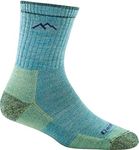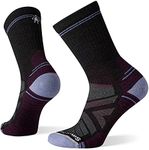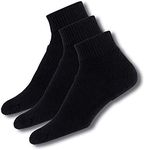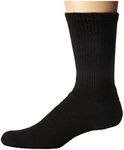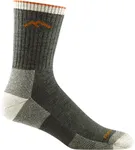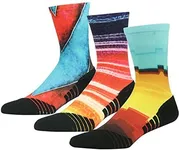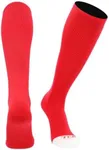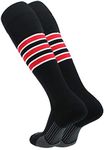Buying Guide for the Best Walking Socks
Choosing the right walking socks is crucial for comfort and performance during your walks. The right pair can prevent blisters, keep your feet dry, and provide the necessary support. When selecting walking socks, consider the material, cushioning, fit, and additional features that cater to your specific needs and walking conditions.MaterialThe material of walking socks is important because it affects breathability, moisture-wicking, and comfort. Common materials include merino wool, synthetic fibers, and cotton. Merino wool is excellent for temperature regulation and moisture-wicking, making it suitable for various weather conditions. Synthetic fibers like polyester and nylon are durable, quick-drying, and often blended with other materials for added comfort. Cotton, while soft, tends to retain moisture and is less ideal for long walks. Choose a material based on the climate you'll be walking in and your personal comfort preferences.
CushioningCushioning in walking socks provides impact protection and comfort. Socks can range from no cushioning (ultra-light) to heavy cushioning. Ultra-light socks are best for warm weather and short walks, offering minimal padding. Light cushioning provides a balance of comfort and breathability, suitable for moderate walks. Medium cushioning offers more padding for longer walks and rougher terrains. Heavy cushioning is ideal for long-distance walking or hiking, providing maximum comfort and protection. Select the level of cushioning based on the duration and intensity of your walks.
FitThe fit of walking socks is crucial for preventing blisters and ensuring comfort. A good fit means the socks should be snug but not too tight, with no excess fabric that can cause friction. Look for socks with a contoured design that matches the shape of your foot. Some socks also have arch support and reinforced heels and toes for added stability and durability. Consider your foot shape and size, and try on different brands and styles to find the best fit for you.
Moisture-WickingMoisture-wicking properties in walking socks help keep your feet dry by drawing sweat away from the skin. This is important for preventing blisters and maintaining comfort during long walks. Materials like merino wool and synthetic fibers are known for their moisture-wicking abilities. If you tend to sweat a lot or walk in humid conditions, prioritize socks with good moisture-wicking properties to keep your feet dry and comfortable.
BreathabilityBreathability in walking socks ensures that your feet stay cool and comfortable by allowing air to circulate. This is particularly important in warm weather or during intense physical activity. Look for socks with mesh panels or ventilation zones that enhance airflow. Breathable socks are typically made from lightweight materials like merino wool or synthetic blends. Choose socks with good breathability if you walk in hot climates or engage in vigorous walking activities.
DurabilityDurability is important for walking socks, especially if you walk frequently or on rough terrains. Durable socks are made from high-quality materials and have reinforced areas like the heel and toe to withstand wear and tear. Synthetic fibers and merino wool are known for their durability. If you plan to walk long distances or on challenging trails, opt for socks that are designed to last and provide consistent performance over time.
